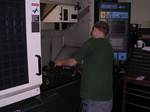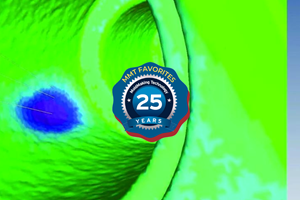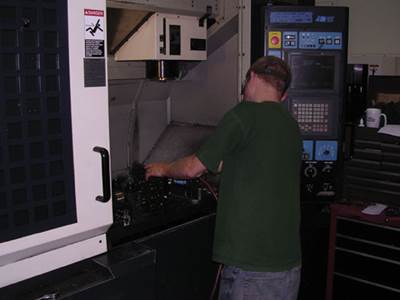The Design Phactory: Churning Out Creative, Complex Mold Designs
“Mold builders make the best designers.”
The Design Phactory, LLC (Zimmerman, MN) was founded by Russ Salzbrun in 2006 when he decided he wanted to be his own boss doing something he loved to do that he was already quite experienced at—intricate mold design—courtesy of an early job opportunity where he was exposed to every aspect of building a mold.
“Sometimes, we would literally build a mold off of a napkin sketch,” Salzbrun comments, “which gave me a great foundation. I always knew that I wanted to eventually design, and after taking courses and learning ProE, my position at the company started evolving to include more design work. I’ve been designing ever since.” The company specializes in the following molds: multi-shot/multi-component, LSR/LIM silicone, metal injection, high cavitation/high production, and auto unscrewing.
His company bills itself as a design firm that closely works with mold shops and OEMs, designing the molds that its customers will then build. The company’s involvement often starts at the product design stage; and other times it starts after the product is already designed and Design Phactory does the mold concept and design. And, all of the designers Salzbrun hires have a toolmaker’s background because he believes it is important that the company’s molds are designed from a toolmaker’s perspective.
Salzbrun has spent the past seven years building a successful business focused on “creative, complex mold design” and problem solving. “Part of my strategy has always been to invest a lot of time automating the tedious parts of the mold design process so we can take more time being creative with the tool design itself,” he elaborates. “I don’t allow us to get bogged down with the tedious tasks. This really enables us to produce a high quality design, at a reasonable price. We always strive to do what’s best for the customer. For example, when a customer of ours came to us wanting us to design molds for small parts they make, I suggested a quick change modular system that enabled them to use small inserts that were unique to the style of parts they were doing. This enabled them to make the inserts ahead of time and drastically reduce their time and cost of manufacturing. Something so simple saved them so much time and money. That’s our goal—to help our customers save time and money. We really enjoy taking on a challenge.”
Diligent in Development
The early days were hectic, Salzbrun recalls. He had an established relationship with one of his former employers who fed him work. The company’s reputation grew quickly from word-of-mouth, and Salzbrun kept picking up clients. “The company was growing so fast and I couldn't keep up with all of the work, so I hired another designer, and then another within the first year,” he says. Currently, The Design Phactory has six full-time designers and clients throughout the U.S. Salzbrun would like to continue to expand his clientele geographically. “We have found that not every geographical location is busy or slow at the same time so it really helps with work flow to have clients in the Midwest, South and on both coasts,” he comments.
Also beneficial is the fact that The Design Phactory has a diverse customer base—anyone from small mom and pop businesses to small OEMs. “Shops like to use us for overflow, especially when they get large packages that they would otherwise have to turn down, Salzbrun notes. “OEMs that choose to work with us do so because they want full control over the design. Usually, once we do a job for a company and they see our expertise and capabilities—and the fact that we can design a mold to their specs—they just keep coming back because they like what we’ve done.”
Tops in Training
One of the company’s biggest challenges occurred the very year it was founded—recruiting new employees. Salzbrun did not want to turn away work, so he began wearing too many hats. He learned an important lesson—to work at pace he could sustain for the long-term. “Part of that process has been delegating, which has been a new thing for me as I've changed from being a single founder to growing into a team of eight,” he says. “Now that we have six full-time designers the capacity issues are much more manageable.”
Design Phactory uses SolidWorks and Creo because those are the programs the company’s customers use, and Salzbrun notes The Design Phactory works to adapt to its customers’ needs. Employees are offered online training through PTC University (ptc.com). “All of our employees have access to Creo training,” Salzbrun notes. “That has made it very easy for our employees who only knew SolidWorks to get up to speed on Creo fairly quickly. I've found that having something online is much more beneficial than sending someone to a class for a week—people seem to absorb more if they can learn at their own pace. The Design Phactory is all about staying ahead of the curve; so if any of our employees want to take a work-related class, we are all for it and will pay for it.”
Engaged in Employees
The company invests a substantial amount of money in its employees’ workspaces. “Besides an ergonomically correct desk, each employee gets a leap chair, two wide screen monitors, and a 3D mouse,” Salzbrun elaborates. “Some people may think I am crazy for spending $750 on a chair, but if it keeps my employees comfortable and without a backache, then it's money well spent. They could get by with one monitor; but since a designer’s workflow involves using multiple programs at any given time, studies have shown that productivity can increase about 40 to 50 percent when using dual monitors. We've put a lot of thought into what would be the most comfortable, creative and productive environment for our employees.”
As for Salzbrun choosing toolmakers to be designers, he notes that, “It is much easier to train a mold builder in software than it is to train a software user how to design molds. Mold builders make the best designers. One of the biggest advantages of training a mold builder who has never designed before is they don't come with any bad habits, so they get trained in a way that keeps all of the processes consistent throughout the company.”
While this philosophy could be deemed risky by some because of the amount of time it takes to train a designer—especially someone who is coming off the shop floor to sit behind a desk—Salzbrun has had nothing but good fortune. “You do run the risk of people wanting to go back to the shop,” he acknowledges. “But, we have been lucky and have heard comments such as, ‘I feel like I’m still building molds, but just on the computer instead of in the shop.’ It’s a risk that has paid off for us.”
Stellar in Service
Salzbrun would like the Design Phactory to evolve into a full-service industrial design firm and provide project management services—with the company managing the project from start to finish. “We will always be a design firm,” Salzbrun emphasizes. “However, thinking long-term, it seems like the next logical step for our company. I want to help facilitate the process of re-shoring manufacturing. Some companies want more control over production as well as better quality and leadtimes. I want to help make that easier. Because of all of our contacts and knowledge that we have in the industry, we feel that we would be a good single point of contact.”
For More Information
The Design Phactory, LLC / (763) 856-9663
tsalzbrun@designphactory.com / designphactory.com
Related Content
How to Achieve Unmatched Accuracy in Very Large Workpieces
Dynamic Tool Corp. purchases two bridge-style double-column CNCs to increase the cutting envelope and maintain 5-micron cutting accuracy in the long term.
Read MoreIntegrated CAD/CAM Streamlines Electrode Manufacture, Improves Quality
A focus on electrode design and automation helps toolroom improve efficiency, reduce tooling costs and deliver higher quality products.
Read MoreOEE Monitoring System Addresses Root Cause of Machine Downtime
Unique sensor and patent-pending algorithm of the Amper machine analytics system measures current draw to quickly and inexpensively inform manufacturers which machines are down and why.
Read MoreCT Scanning Helps Micro Molder Reduce Cost of First Article Inspections
CT scanning services performed by 3D ProScan, a division of NyproMold Inc. provides MTD Micro Molding with accurate, high-resolution internal and external measurements performed about seven times faster and at significant cost savings.
Read MoreRead Next
Rapid Mold Solutions, Inc.: Three-Pronged Approach to Prototype/Production Mold Manufacture
According to Rapid Mold Solutions President Damian Kuzmin, the company’s business plan was a simple one at the onset. “We wanted to service the prototyping needs of the Big 3 and the Tier 1s that supplied their specialty component needs,” he states, “we learned how to design, build, and produce parts at the price point and timing necessary to earn a lot of business quickly”. The difficult part, as it turned out, was determining what to name the new venture. ‘Radiator Mold Shop’ just wasn’t conducive to future expansion into new markets, so from the acronym RMS, Rapid Mold Solutions was born.”
Read MoreHow to Use Continuing Education to Remain Competitive in Moldmaking
Continued training helps moldmakers make tooling decisions and properly use the latest cutting tool to efficiently machine high-quality molds.
Read MoreReasons to Use Fiber Lasers for Mold Cleaning
Fiber lasers offer a simplicity, speed, control and portability, minimizing mold cleaning risks.
Read More









.jpg;maxWidth=300;quality=90)











